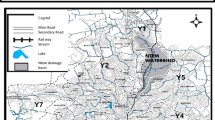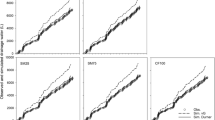Abstract
An empirical approach is made in this investigation to predict the leached concentrations of sodium (Na), calcium (Ca), and potassium (K) in the effluents from a landfill site. Water at certain predetermined inflow filling rate is applied to a specific ponding depth, at the top of an experimental column filled with landfill refuse soil at the top (upper layer) and normal local soil at the bottom (base layer). The water infiltrates into the upper layer soil, percolates through the pores in upper and base layers, and in the process leaches the nutrients from the soils that are collected at the bottom of the column. The experimentations were for different combinations of heights of upper and base layer soils, water ponding depth, and inflow filling rates. The nutrient concentrations in the outflow leachates are measured using flame photometer. The observations showed mixed responses of leaching and trapping of nutrients in the soil layers for the various combinations. The experimental observations also inferred that the nutrient leaching is more for cases involving higher ponding depths and higher inflow filling rates. Empirical relationships with respect to the geometrical parameters, to predict the leached concentrations of Na, Ca, and K, are developed from the experimental observations using nonlinear least squares regressive techniques. Exponential equations gave the best empirical fit among various nonlinear relations in the regression technique. The empirical models also predicted well for each subcategory of independent variables that are substantiated by high correlation coefficients.














Similar content being viewed by others
References
Bernstad A, Jansen JLC (2011) A life cycle approach to the management of household food waste—a Swedish full-scale case study. Waste Manag 31:1879–1876. doi:10.1016/j.wasman.2011.02.026
Boldrin A, Andersen JK, Christensen TH (2011) Environmental assessment of garden waste management in the municipality of Aarhus, Denmark. Waste Manag 31:1560–1569. doi:10.1016/j.wasman.2011.01.010
Cao X, Liang Y, Zhao L, Le H (2013) Mobility of Pb, Cu, and Zn in the phosphorus-amended contaminated soils under simulated landfill and rainfall conditions. Environ Sci Pollut R 20:5913–5921. doi:10.1007/s11356-012-1349-3
Elineema G, Kim JK, Hilonga A, Shao GN, Kim YN, Quang DV, Sarawade PB, Kim HT (2013) Quantitive recovery of high purity nanoporous silica from waste products of the phosphate fertilizer industry. J Ind Eng Chem 19:63–67. doi:10.1016/j.jiec.2012.07.001
GRETL (2014) GNU regression, econometrics and time-series library (user’s guide). (http://gretl.sourceforge.net/gretl-help/gretl-guide.pdf) Accessed last on 14-August-2014
Jung IS, Lovitt RW (2011) Leaching techniques to remove metals and potentially hazardous nutrients from trout farm sludge. Water Res 45:5977–5986. doi:10.1016/j.watres.2011.08.062
Kartha SA, Srivastava R (2012) Slow and fast transport in heap leaching of precious metals. Transport Porous Med 94(3):707–727. doi:10.1007/s11242-012-0020-2
McBean EA, Rovers FA, Farquhar GJ (1995) Solid waste landfill engineering and design. Prentice Hall PTR, New Jersey
Min JE, Kim M, Kim JY, Park IS, Park JY (2010) Leachate modeling for a municipal solid waste landfill for upper expansion. KSCE J Civil Eng 14(4):473–480. doi:10.1007/s12205-010-0473-1
Ozkaya B, Demir A, Bilgili MS (2006) Mathematical simulation and long-term monitoring of leachate components from two different landfill cells. J Hazard Mater A135:32–39. doi:10.1016/j.jhazmat.2005.11.059
Palma LD, Mecozzi R (2010) Batch and column tests of metal mobilization in soil impacted by landfill leachate. Waste Manag 30:1594–1599. doi:10.1016/j.wasman.2010.04.003
Schonsky H, Peters A, Lang F, Abel S, Mekiffer B, Wessolek G (2013) Sulfate transport and release in technogenic soil substrates: experiments and numerical modeling. J Soils Sediments 13:606–615
Sharma N (1994) Recycling of organic waste through earthworms: an alternative source of organic fertilizer for crop growth in India. Energy Convers Mgmt 35(1):25–50
Sivakumar D (2013) Experimental and analytical model studies on leachate volume computation from solid waste. Int J Environ Sci Technol 10:903–916. doi:10.1007/s13762-012-0083-1
Srivastava SK, Tyagi R (1995) Competitive adsorption of substituted phenols by activated carbon developed from fertilizer waste industry. Water Res 29:483–488
Wilson DC, Young PJ, Hudson BC, Baldwin G (1982) Leaching of cadmium from pigmented plastics in a landfill site. Environ Sci Technol 16(9):560–566
Yusof N, Haraguchi A, Hasan MA, Othaman MR, Wakisaka M, Shirai Y (2009) Measuring organic carbon, nutrients and heavy metals in rivers receiving leachate from controlled and uncontrolled municipal solid waste (MSW) landfills. Waste Manag 29:2666–2680. doi:10.1016/j.wasman.2009.05.022
Zhao W, Xi BD, Zhao Y, Zhu CW, Wei ZM, Yuan Y, Zhang D (2014) Effect of dissolved organic matter in simple landfill leachate on the dissolution and migration of Pb(II). Res Environ Sci 27(5):527–533
Author information
Authors and Affiliations
Corresponding author
Additional information
Responsible editor: Michael Matthies
Rights and permissions
About this article
Cite this article
Barman, P.J., Kartha, S.A. & Pradhan, B. Empirical approach to predict leached nutrients from landfill site. Environ Sci Pollut Res 22, 6619–6633 (2015). https://doi.org/10.1007/s11356-014-3844-1
Received:
Accepted:
Published:
Issue Date:
DOI: https://doi.org/10.1007/s11356-014-3844-1




